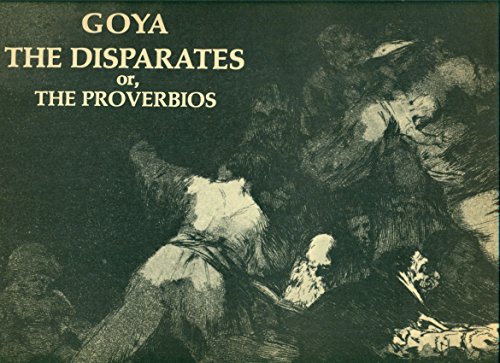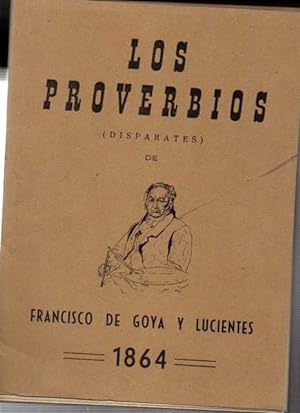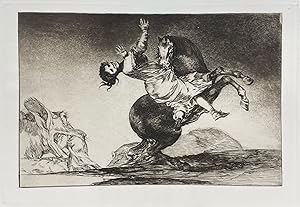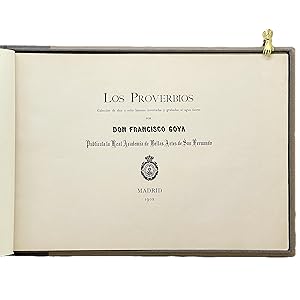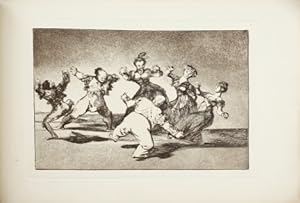proverbios de francisco goya lucientes (16 resultados)
ComentariosFiltros de búsqueda
Tipo de artículo
- Todos los tipos de productos
- Libros (15)
- Revistas y publicaciones (No hay ningún otro resultado que coincida con este filtro.)
- Cómics (No hay ningún otro resultado que coincida con este filtro.)
- Partituras (No hay ningún otro resultado que coincida con este filtro.)
- Arte, grabados y pósters (1)
- Fotografías (No hay ningún otro resultado que coincida con este filtro.)
- Mapas (No hay ningún otro resultado que coincida con este filtro.)
- Manuscritos y coleccionismo de papel (No hay ningún otro resultado que coincida con este filtro.)
Condición
Encuadernación
Más atributos
- Primera edición (1)
- Firmado (No hay ningún otro resultado que coincida con este filtro.)
- Sobrecubierta (1)
- Con imágenes (8)
- No impresión bajo demanda (16)
Idioma (3)
Gastos de envío gratis
Ubicación del vendedor
Valoración de los vendedores
-
Goya The Disparates or The Proverbios
Librería: Wonder Book, Frederick, MD, Estados Unidos de America
EUR 12,05
Convertir monedaGratis gastos de envío en Estados Unidos de AmericaCantidad disponible: 1 disponibles
Añadir al carritoCondición: Good. Good condition. A copy that has been read but remains intact. May contain markings such as bookplates, stamps, limited notes and highlighting, or a few light stains.
Más opciones de compra de otros vendedores en IberLibro
Nuevo desde EUR 82,94
Usado desde EUR 12,05
Encuentre también Tapa blanda
-
The Disparates : or, the Proverbios [22 plates].
Publicado por New York ; Dover, 1969
Idioma: Inglés
Librería: Antiquariat Thomas Haker GmbH & Co. KG, Berlin, Alemania
Miembro de asociación: GIAQ
EUR 10,00
Convertir monedaEUR 12,00 gastos de envío desde Alemania a Estados Unidos de AmericaCantidad disponible: 1 disponibles
Añadir al carritoSoftcover/Paperback. Condición: Gut. 2, 22 p. ; 22 plates. Guter Zustand. 22 Tafeln. Einband mit leichten Gebrauchsspuren. Seiten sauber. / Good. 22 plates. Cover shows mild wear. Clean pages. Sprache: Englisch Gewicht in Gramm: 490.
-
The Disparates or, The Proverbios, with a new introduction by Philip Hofer
Publicado por Dover Publications Inc., New York, 1969
Librería: Graphem. Kunst- und Buchantiquariat, Berlin, Alemania
EUR 18,00
Convertir monedaEUR 6,80 gastos de envío desde Alemania a Estados Unidos de AmericaCantidad disponible: 1 disponibles
Añadir al carritoquer gr 4°, Brosch., ohne Paginierung - Ex Libris. Gutes Exemplar. Buch.
-
Goya the disparates or the proverbios
Publicado por Dover Publications, 1969
Librería: Librodifaccia, Alessandria, AL, Italia
EUR 8,52
Convertir monedaEUR 27,90 gastos de envío desde Italia a Estados Unidos de AmericaCantidad disponible: 1 disponibles
Añadir al carritoCondición: Buone. italiano Condizioni dell'esterno: copertina leggermente logorata ai bordi Condizioni dell'interno: Buone.
-
LOS PROVERBIOS (DISPARATES). 1864.
Publicado por Impr. Agustin Jimenez. s.a., Madrid.
Librería: Gulliver's Books Never Die, Madrid, MAD, España
EUR 25,00
Convertir monedaEUR 25,00 gastos de envío desde España a Estados Unidos de AmericaCantidad disponible: 1 disponibles
Añadir al carrito21x16. 18 láms. Rústica ed. Ilstr., 18 láminas. Muy buen estado. LIBRO EN ESPAÑOL.
-
Los dispatrates ó Los proverbios. Reproducción de las veintidós láminas de la edición publicada en el año 1864 por la Real Academia de Nobles Artes de San Fernando.
Idioma: Español
Librería: ORTIZ MARCOS Libros Antiguos, Madrid, España
EUR 40,00
Convertir monedaEUR 15,00 gastos de envío desde España a Estados Unidos de AmericaCantidad disponible: 1 disponibles
Añadir al carritoEncuadernación de tapa dura. Condición: Bien. Madrid, J. Pérez del Hoyo editor, s.f. (ca. 1980). Carpeta conteniendo las 22 láminas. Folio apasisado (27x38 cm.). Buen estado de conservación.
-
PROVERBIOS (DISPARATES). Reproducciones de la tirada de 1864 que se conserva en la Biblioteca Nacional de España. Edición dirigida por Antonio de Horna López.
Publicado por SOCIEDAD GENERAL DE AUTORES DE ESPAÑA. Impresor AGUSTIN JIMENEZ. Fotograbador ORTEGA., MADRID, 1961
Idioma: Español
Librería: Librería de Lance La Dulcinea, MADRID, Calle Hermosilla Nº, 132, España
EUR 75,00
Convertir monedaEUR 23,00 gastos de envío desde España a Estados Unidos de AmericaCantidad disponible: 1 disponibles
Añadir al carritoEncuadernación de tapa blanda. Condición: Bien. Estado de la sobrecubierta: Bien. Edición numerada de 300 Ejemplares. Bonita edición de los PROVERBIOS (DISPARATES) de FRANCISCO DE GOYA, edición de 300 ejemplares numerados (se ofrece el Nº 60) dirigida por Antonio de Horna López, de la Sociedad General de Autores de España. En Carpeta original en cartulina negra ilustrada y lazo de seda, conteniendo portada frontis con justificación editorial y las 18 láminas. Buen estado general de conservación.
-
Los disparates o Los proverbios
Publicado por J. Pérez del Hoyo.
Librería: Alcaná Libros, Madrid, España
EUR 31,90
Convertir monedaEUR 40,00 gastos de envío desde España a Estados Unidos de AmericaCantidad disponible: 1 disponibles
Añadir al carritotapa blanda. Condición: Bien. Arte. Bellas Artes. Deportes.(7) J. Pérez del Hoyo. Madrid. 27 x 38 cm. 22 lám. Encuadernación en carpeta. Repr. de la ed. de Madrid de 1864 . Cubierta deslucida. (=3293829=) PB216.
-
EUR 55,50
Convertir monedaEUR 18,00 gastos de envío desde Francia a Estados Unidos de AmericaCantidad disponible: 1 disponibles
Añadir al carritoPas de couverture. Condición: bon. R100079239: non daté. In-Folio. En feuillets. Bon état, Couv. convenable, Dos satisfaisant, Intérieur frais. Chemise souple à 3 rabats contenant 22 planches en noir et blanc - planches collationnées - en supplément une plaquette dépliante "Fundacion Juan March Goya grabador" - texte en espagnol. . . A l'italienne. Classification Dewey : 460-Langues espagnole et portugaise.
-
Los Proverbios: Coleccion de diez y ocho laminas inventadas y grabadas al agua fuerte por Don Francisco Goya. Publicala la R! Academia de Nobles Artes de San Fernando
Publicado por La Real Academia de Nobles Artes de San Fernando, Madrid, 1864
Librería: Donald A. Heald Rare Books (ABAA), New York, NY, Estados Unidos de America
Original o primera edición
EUR 43.474,49
Convertir monedaGratis gastos de envío en Estados Unidos de AmericaCantidad disponible: 1 disponibles
Añadir al carritoComplete set of 18 etchings with aquatint and drypoint, executed 1816-24, on heavy wove paper, richly printed impressions from the First published in an edition of three hundred copies, with the lithographic title page on heavy wove paper, without watermarks. Plate sizes: 9 1/2 x 14 inches. Sheet sizes: 12 x 17 1/2 inches. Quarter morocco over 19th century marble paper boards. Spine lettered gilt First edition, one of 300 copies, of Goya's last print series, completed in the years between 1815 and 1824. The original series comprised 22 plates. These copper plates were left with Goya's son Xavier on his departure from Spain in 1824. The plates remained hidden until Xavier's death in 1854. After which time, 18 of the plates passed through two different owners before they came to the Royal Academy of San Fernando in 1862, where they were published in this first, posthumous edition in 1864. Four remaining plates were discovered in Paris in the early 1870s, and were eventually published in the periodical, L'Art, in 1877. Evidence suggests that Goya started work on this series in 1815 and continued until 1819. When he left Spain and the absolutist regime of King Fernando VII for exile in Bordeaux, France, in 1824, he effectively left the proofs of Los Proverbios in wooden boxes in Spain, and never returned to them. Although Goya almost certainly intended to publish the series, it was never published in his lifetime. The first edition, published by the Real Academia de Nobles Artes de San Fernando, Madrid, in 1864 was at the time titled Los Proverbios (Proverbs). It quickly became apparent that the mysterious scenes depicted by Goya were not illustrating proverbs at all, but in 1864 the proofs Goya had produced in his lifetime were not known, nor was his title for them, Los Disparates (Follies). The series was made in a very particular political and personal context for Goya, at a time when he was not in the court's favour anymore, the new King Fernando VII preferring the court painter Vicente López (1772-1850) to him. Goya had confined himself to his house and focused on a world of his own, fully aware of the political situation and events around him but artistically removed from the demands of the court. The works also came at the end of the War of Independence (the Peninsular War, 1808-1814), the horrors of which the artist had unapologetically explored in one of his other great print series, Los Desastres de la Guerra. This context allowed Goya's fierce imagination to develop in Los Proverbios, in a work stunningly modern for its time. Deltiel 202-219; Harris 248-265.
-
LOS PROVERBIOS COLECCIÓN DE DIEZ OCHO LÁMINAS INVENTADAS Y GRABADAS AL AGUA FUERTE POR DON FRANCISCO GOYA. PUBLÍCALA LA REAL ACADEMIA DE BELLAS ARTES DE SAN FERNANDO (4ª EDICIÓN, 1902)
Publicado por Calcografía Nacional, 1902
Librería: LIBRERIA ANTICUARIA MARGARITA DE DIOS, MADRID, España
Arte / Grabado / Póster
EUR 20.000,00
Convertir monedaEUR 30,00 gastos de envío desde España a Estados Unidos de AmericaCantidad disponible: 1 disponibles
Añadir al carritoSin Encuadernar. Condición: Muy bien. Materia: Colección de Aguafuertes. Goya. Los Proverbios. Arte. Publicación: Madrid, Real Academia de San Fernando, 1902. 4ª edición. Descripción física: 34,5 x 49,5 cm. Portada, 18 láminas grabadas al aguafuerte. Cubiertas de papel. Carpeta. Técnica: Grabado al aguafuerte. Medidas del papel 34,5 x 49,5 cm. Tinta negra. Edición de 100 ejemplares. Conservación: Ejemplar muy limpio y bien conservado con todos sus márgenes. Notas: La última gran serie de grabados hecha por Goya fue la de Los disparates, que también se denominó Los proverbios. Comenzó a prepararla en 1816, pero debió de quedar sin concluir cuando marchó a Francia en 1824, ante la vuelta del absolutismo, tras el Trienio Liberal. Por ello no fue editada en vida del artista. De las veintidós planchas que componen la serie, dieciocho fueron editadas en 1864 por la Real Academia de Bellas Artes de San Fernando y las cuatro restantes se publicaron en París en 1877. Los Disparates son unos grabados difíciles de interpretar por sus enigmáticas imágenes y carecen de una unidad o lógica narrativa. Se desconoce la ordenación que Goya les hubiera dado. En cuanto a los títulos solo se conocen originariamente los de trece, gracias, a las pruebas de estado, y todos ellos comienzan por la palabra disparate. Los que aparentemente parecen temas lúdicos y desenfadados, carnavalescos, adquieren un aire siniestro y tenebroso por el dramatismo de la luz nocturna. La mayoría de los asuntos abordados en Los disparates, ya habían sido tratados por Goya en Los caprichos, pero ahora lo hace con un sentido dramático o grotesco. UCSS1.
-
Los Proverbios. Colleccion de diez y ocho laminas invetadas y grabadas al agua fuerte.
Año de publicación: 1891
Librería: Librairie Camille Sourget, Paris, Francia
Miembro de asociación: ILAB
EUR 30.000,00
Convertir monedaEUR 30,00 gastos de envío desde Francia a Estados Unidos de AmericaCantidad disponible: 1 disponibles
Añadir al carritoCouverture rigide. Condición: Très bon. Publicala la Real Academia de Nobles Artes de San Fernando, Madrid, 1891. Album in-folio comprenant un titre et la suite complète de 18 eaux-fortes publiées sous le titre « Los Proverbios » mais dont le titre prévu par Goya était « Disparates » (Extravagances). Brochure verte de l'époque défraichie. 315 mm x 490 mm. --- Troisième édition, premier tirage imprimé à quelques dizaines d'exemplaires seulement. Harris, 248-265 ; Delteil 202-219. D'autres éditions furent imprimées, notamment en 1864, en 1875, en 1902, en 1904. Un industriel espagnol, primitivement propriétaire des cuivres, avait donné une édition différente en 1850. Elle est aujourd'hui introuvable. « This edition is well printed on suitable paper » (Harris). Seuls 100 exemplaires de cette troisième édition, tirages a et b confondus, furent imprimés. « Dans le premier tiers du XIXe siècle, domine en Espagne l'un des plus grands artistes des temps modernes et dont la haute valeur dépasse toutes les frontières : Goya y Lucientes. Une partie de l'?uvre de ce maître repose sur le XVIIIe siècle : ses traductions des peintures de Velasquez, quelques planches isolées et rares, puis sa célèbre série des ?Caprices'. Toutefois, une autre portion de son ?uvre, au moins d'égal intérêt, a vu le jour au XIXe siècle, comme la ?Tauromachie', les ?Désastres de la Guerre', les ?Disparates' et ses belles lithographies, comme les ?Taureaux', dits de Bordeaux, qui eurent une influence indéniable sur Eugène Delacroix. L'?uvre gravé et lithographié de Goya est très important. Il ne renferme pas moins de 288 pièces qui placent leur auteur parmi les maîtres les plus extraordinaires et les plus attirants de l'estampe, tant par la science, la fantaisie, l'imagination, la profondeur de pensée, l'indépendance d'esprit, la puissance d'exécution, la verve enfin qui traversent son ?uvre, qu'il s'agisse des ?Caprices' ou des ?Désastres de la Guerre', et le rende /// Publicala la Real Academia de Nobles Artes de San Fernando, Madrid, 1891. Folio album [315 mm x 490 mm] made of one title and the complete suite of 18 etchings published under the title "Los Proverbios" but which scheduled title was "Disparates" (Extravagances). Brown contemporary wrappers. --- Third edition, first issue printed in only about ten copies. Harris, 248-265; Delteil 202-219. Other editions were printed, in 1864, in 1875, in 1902, in 1904. A Spanish industrial, initially owner of the copper plates, had given another edition in 1850. It is nowadays nowhere to be found. "This edition is well printed on suitable paper" (Harris). Only 100 copies of this third edition, irrespective of issue (A and B), were printed. "The meaning of the word ?disparate' is perhaps closer to the French word ?sottise' which Delteil uses, than the English ?non-sense' of ?absurdity'. The Spanish ?disparate' evokes a feeling of pity for the absurdity or non sense rather than disapproval or blame, and is best translated into English as ?folly'". T. Harris. "In the first third of the 19th century, Spain is dominated by the greatest artist of modern times whose high value goes beyond all borders: Goya y Lucientes." Loÿs Delteil. Uncut copy of Goya's last great work. It was engraved by the artist after La Tauromaquía, in the 1818-1820's, a period during which Goya went right back to the Spanish popular life he always loved.


